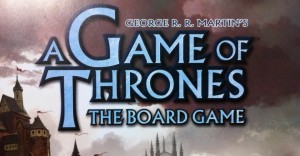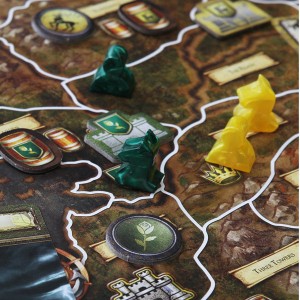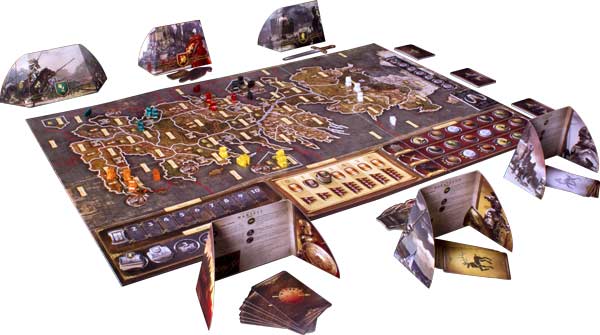Friday Night Unplugged #23.1: A Game Of Thrones The Boardgame
- Updated: 12th Jul, 2013
Welcome back to Friday Night Unplugged. I hope you have your furs to hand and a sword in reach as things are about to get nasty on the FNU table. This time we’re breaking open the suitably epic A Game of Thrones the Boardgame Second Edition for a battle of wits, alliances and deception. This week of course, as with any of our 2-parters I’ll break down the core of the game and explain some of the rules, ready for next week’s huge play-report.
The Basics:
In A Game of Thrones: The Boardgame each player takes on the role of one of the major houses of Westeros vying for control of the land. The board itself is a sprawling map split out into the different regions. Each house starts with a few troops in and around its home region, a stack of orders and influence and a player shield to hide these behind. Winning is simple; you need to control a set number of Strongholds or control the most at the end of the games last turn.
Each round starts with the order phase where players place orders face down on any area they control with a unit. Then all players reveal their placed orders and resolve them in an order determined by the influence track. Each player has the same range of orders to choose from but only have a finite amount of each. The available orders are as follows and each has a special, more powerful, alternative, such as a creating new units or removing opponents:
- March: march orders allow you to move units from one area to another adjacent, marching across seas requires controlling a boat unit. Marching units are also affected by a players supply value which limits army sizes.
- Support: support orders allow units to aid in adjacent combats
- Raid: raid orders allow the player to remove an adjacent support, raid or consolidate power order.
- Defense: defense orders allow the player to add extra points to any units defending during combat in the area the order was placed during this turn.
- Consolidate Power: consolidate power orders grant the player one power token from their house pool + 1 extra for each power icon printed in that space.
Alongside the various orders, the influence tracks define the state of politics in Westeros. A few times per game players get to bid on each of the three tracks. Bidding works with each player secretly choosing an amount of power tokens they own and all players then revealing them. The highest bid wins and that player loses that amount of tokens and gains the relevant token for that track. Each has its own perks, from choosing the winner of ties to having extra power in combat.
At the beginning of each round Westeros cards are resolved. These can change everything from supply levels to the number of march orders a player can use in a round.
Combat is also stupidly simple – each unit is worth a number of points. Combat begins whenever two sets of units from different houses share a space. Whoever controls the most points wins the combat and the opponent’s units retreat. Adjacent units with support orders can add their numbers to either side of the combat and each player gets a chance to add a character card from their house to the fray for bonus points or to gain some form of compensation in the event of a loss. Simple and fluid.
In short, the aim of the game is to create and move units around the map, establishing control of supply icons to increase potential army size. All the while, players are defending enemy attacks and launching offensives to control new strongholds or gaining more power to then bid on the influence tracks. In turn that allows you to shape the flow of the game but you then have 2-5 other people to contend with all trying to do the same thing on an increasingly cramped map with each player trying to outwit their other opponent and nobody knowing who to trust. Piece of cake.
What we think:
A Game of Thrones: The Boardgame does a spectacular job of emphasising the pure scale of G. R. R. Martin’s world. The huge board is split into regions, realms and areas. The momentum of controlling and manipulating your troops and others helps to reinforce the feeling of being in control of an army.
At its heart it is a game about power whether it be military might, political or just great tactical thinking. The various influence tracks enable all kinds of gameplay shenanigans depending on the type of play you wish to make. Conversation and deal-making is not just allowed but actively encouraged. Players are free to negotiate, treatise and of course double cross to their hearts’ extent and once the game hits the later turns, it’s even unavoidable.
While A Game of Thrones: The Boardgame stands on its own feet as well-designed, tactical game it really exceeds expectations for fans of the books. The rulebook and cards are filled with beautiful detailed artwork from the world of Westeros and each of the major houses is represented, from the loyal House Stark to the scheming house Lannister. The board is worthy of framing and hanging on a wall for the sheer level of detail included.
There is one problem, at least I hesitate to call it a problem. A Game of Thrones: The Boardgame is huge. As I’ve said the scale is enormous and while the box says it can be successfully played with 3 players at the least the truth is… it loses something. To really get a grip on the depth that the rule system allows, you need to play a full 6 player game, which isn’t something to undertake lightly. You see, a 3 player game can easily clock in at 2 hours with players that know the rules well but a 6 player game? That’s a force to be reckoned with. Teported play times range anywhere from 5-8 hours with some taking much much longer.
Despite the epic playtime I still have to recommend you play A Game of Thrones the Boardgame. It’s brilliant. Everything from the secret information and bidding on influence to the fluid combat system is well thought out and surprisingly intuitive for what is another big box Fantasy Flight game. Of course if you still aren’t sure then you can come back next week for an equally epic play-report of a 3 player game and our final thoughts.
Next Week:
We battle it out in an epic 3 player game and you get to read what happens. Do you side with House Stark, Lannister or Baratheon? Come back next week to see who succeeds in controlling Westeros.




Follow Us!